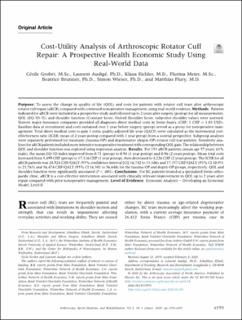Please use this identifier to cite or link to this item:
https://doi.org/10.21256/zhaw-20806| Publication type: | Article in scientific journal |
| Type of review: | Peer review (publication) |
| Title: | Cost-utility analysis of arthroscopic rotator cuff repair : a prospective health economic study using real-world data |
| Authors: | Grobet, Cécile Audigé, Laurent Eichler, Klaus Meier, Flurina Brunner, Beatrice Wieser, Simon Flury, Matthias |
| et. al: | No |
| DOI: | 10.1016/j.asmr.2020.02.001 10.21256/zhaw-20806 |
| Published in: | Arthroscopy, Sports Medicine, and Rehabilitation |
| Volume(Issue): | 2 |
| Issue: | 3 |
| Page(s): | 193 |
| Pages to: | 205 |
| Issue Date: | 25-Apr-2020 |
| Publisher / Ed. Institution: | Elsevier |
| ISSN: | 2666-061X |
| Language: | English |
| Subject (DDC): | 362.1041: Health economics |
| Abstract: | Purpose: To assess the change in quality of life (QOL) and costs for patients with rotator cuff tears after arthroscopic rotator cuff repair (aRCR) compared with continued nonoperativemanagement, using real-world evidence. Methods: Patients indicated for aRCR were included in a prospective study and followed up to 2 years after surgery (postop) for allmeasurements. QOL (EQ-5D-5L) and shoulder function (Constant Score, Oxford Shoulder Score, subjective shoulder value) were assessed. Sixteen major insurance companies provided all-diagnoses direct medical costs in Swiss francs (CHF; 1 CHF ¼ 1.03 USD). Baseline data at recruitment and costs sustained over 1 year before surgery (preop) served as a proxy for nonoperative management. Total direct medical costs to gain 1 extra quality-adjusted life year (QALY) were calculated as the incremental costeffectiveness ratio (ICER; mean of 2 years postop compared with 1 year preop) from a societal perspective. Subgroup analyses were separately performed for traumatic (trauma-OP) and degenerative (degen-OP) rotator cuff tear patients. Sensitivity analyses for aRCR patients includedmore intensive nonoperative treatment with corresponding QOL gain. The relationship between QOL and shoulder function was explored using regression analysis. Results: For 153 aRCR patients (mean age 57 years; 63% male), themean EQ-5D index improved from 0.71 (preop) to 0.94 (1 year postop) and 0.96 (2 years postop). Mean total costs increased from 5,499 CHF (preop) to 17,116 CHF (1 year postop), then decreased to 4,226CHF (2 years postop). The ICER for all aRCR patients was 24,924 CHF/QALY (95%confidence interval [CI] 16,742 to 33,106) and 17,357 CHF/QALY (95% CI 10,951 to 23,763) and 36,474 CHF/QALY (95% CI 16,301 to 56,648) for the trauma-OP and degen-OP groups, respectively. QOL and shoulder function were significantly associated (P < .001). Conclusions: For RC patients treated at a specialized Swiss orthopaedic clinic, aRCR is a cost-effective intervention associated with clinically relevant improvement in QOL up to 2 years after repair compared with prior nonoperative management. Level of Evidence: Economic Analyses e Developing an Economic Model, Level II |
| URI: | https://digitalcollection.zhaw.ch/handle/11475/20806 |
| Fulltext version: | Published version |
| License (according to publishing contract): | CC BY-NC-ND 4.0: Attribution - Non commercial - No derivatives 4.0 International |
| Departement: | School of Management and Law |
| Organisational Unit: | Winterthur Institute of Health Economics (WIG) |
| Appears in collections: | Publikationen School of Management and Law |
Files in This Item:
| File | Description | Size | Format | |
|---|---|---|---|---|
| 2020_Grobet-Audige-Eichler_Cost-utility-analysis.pdf | 1.5 MB | Adobe PDF |  View/Open |
Show full item record
Grobet, C., Audigé, L., Eichler, K., Meier, F., Brunner, B., Wieser, S., & Flury, M. (2020). Cost-utility analysis of arthroscopic rotator cuff repair : a prospective health economic study using real-world data. Arthroscopy, Sports Medicine, and Rehabilitation, 2(3), 193–205. https://doi.org/10.1016/j.asmr.2020.02.001
Grobet, C. et al. (2020) ‘Cost-utility analysis of arthroscopic rotator cuff repair : a prospective health economic study using real-world data’, Arthroscopy, Sports Medicine, and Rehabilitation, 2(3), pp. 193–205. Available at: https://doi.org/10.1016/j.asmr.2020.02.001.
C. Grobet et al., “Cost-utility analysis of arthroscopic rotator cuff repair : a prospective health economic study using real-world data,” Arthroscopy, Sports Medicine, and Rehabilitation, vol. 2, no. 3, pp. 193–205, Apr. 2020, doi: 10.1016/j.asmr.2020.02.001.
GROBET, Cécile, Laurent AUDIGÉ, Klaus EICHLER, Flurina MEIER, Beatrice BRUNNER, Simon WIESER und Matthias FLURY, 2020. Cost-utility analysis of arthroscopic rotator cuff repair : a prospective health economic study using real-world data. Arthroscopy, Sports Medicine, and Rehabilitation. 25 April 2020. Bd. 2, Nr. 3, S. 193–205. DOI 10.1016/j.asmr.2020.02.001
Grobet, Cécile, Laurent Audigé, Klaus Eichler, Flurina Meier, Beatrice Brunner, Simon Wieser, and Matthias Flury. 2020. “Cost-Utility Analysis of Arthroscopic Rotator Cuff Repair : A Prospective Health Economic Study Using Real-World Data.” Arthroscopy, Sports Medicine, and Rehabilitation 2 (3): 193–205. https://doi.org/10.1016/j.asmr.2020.02.001.
Grobet, Cécile, et al. “Cost-Utility Analysis of Arthroscopic Rotator Cuff Repair : A Prospective Health Economic Study Using Real-World Data.” Arthroscopy, Sports Medicine, and Rehabilitation, vol. 2, no. 3, Apr. 2020, pp. 193–205, https://doi.org/10.1016/j.asmr.2020.02.001.
Items in DSpace are protected by copyright, with all rights reserved, unless otherwise indicated.